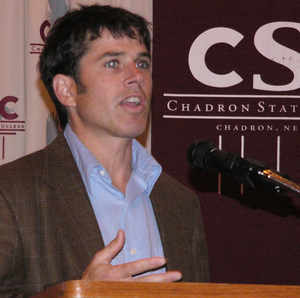Renewable energy growing in prominence, audience told

Energy consumption is growing at a rapid rate and conventional sources are becoming more scarce and much more costly, but there is a light at the end of the tunnel, an audience at Chadron State College was told Monday night.
John Brown, a project manager from the National Renewable Energy Laboratory at Golden, Colo., said development of renewable energy and energy efficiency are helping answer the nation’s and even the world’s thirsty for more energy.
Brought to CSC as part of the college’s Distinguished Speakers Series, Brown said mankind has just begun to tap of the energy sources that are possible. He added that numerous government programs and considerable expertise are available to assist communities wishing to utilize renewable energy.
The laboratory where Brown works is one of 13 research facilities in the United States, but the only one that focuses on renewable energy and energy efficiency. Some 1,100 people work at the lab, which not only strives to develop new sources of energy, but also tests potential products from around the world.
Brown said the world probably won’t will run out of petroleum products, but he expects them to become “very, very, very expensive.” He said wind, solar, geothermal, biomass and hydrogen are constantly being tested and utilized to help replace oil and natural gas.
A positive for wind and solar energy, the speaker said, is that once the initial investment is made the cost of production does not increase. For this reason, he said numerous energy companies are investing in wind farms and solar systems as a hedge against the rising cost of conventional sources.
Brown said numerous areas of Nebraska have adequate winds to produce electricity with turbine units, but lack of transmission capacity is a hindrance.
He also reported that there are 50 solar-powered water pumping units being used in, the area served by Northwest Rural Public Power District in Dawes County and northern Sheridan County.
Trees, grass, agricultural crops, animal waste and municipal solid waste dumps are biomass products being used to generate energy in some areas, Brown said.
He noted that California Gov. Arnold Schwarzennegger has proposed that by 2008 any housing development with 25 or more units in his state must build a solar system that will generate a portion of its energy. He also said that Shell Oil Co. wants to have 50 percent of the energy it supplies to come from renewable sources by 2060.
The speaker also reported that numerous breakthroughs have occurred in energy efficiency. He said conventional 60 watt light bulbs produce about as much heat as light and use $14.50 in electricity if they are on 12 hours a day for a year. They can be replaced by 15 watt energy-efficient bulbs that provide the same light for $3.61.
Good roofs and windows are a wise investment for homeowners, Brown said, because they not only keep out the elements, but also permit the use of smaller furnaces and air conditioners
Cyd Janssen of Chadron, a rural development specialist for the U.S. Department of Agriculture, reported during the program that the government will provide energy-efficiency loans of up to $20,000 for 20 years at 1 percent interest to newlyweds. She also said grants of up to $7,500 are available to low-income individuals to make energy efficiency improvements on their property.
Janssen was instrumental in bringing Brown to Chadron. Earlier in the day he spoke to public school students and visited with public power officials.
Loree MacNeill, CSC director of college relations, said next semester’s Distinguished Speakers Series will focus on drought and water issues.
Category: Campus Events, Campus News
